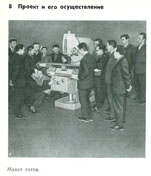Observer and Observed in Soviet State Design Institutes, 1960s-90s
This project studies the influence and importance of the observational techniques used by artists on other sciences in one of the major research institutes in the Soviet Union: VNIITE – All-Union Scientific Research Institute of Industrial Design (Vsesoiuznyi nauchno-issledovatel’skii institut tekhnicheskoi estetiki), founded in Moscow in 1962 under the auspices of the State Committee of Science and Engineering of the Council of Ministers of the USSR (Gosudarsstvennyi Komitet po nauke i tekhniki Soveta Ministrov SSSR). One of the ideas behind this new research institute was to “invent” new design methods within the planning economy by maximally exploring the relation technology - science - art. The need to “catch up with the west” was considered urgent.

Five years later, 15 branches of VNIITE had been founded all over USSR with about 200 additional “artists-construction” (i.e., design) groups with "laboratories". Within just a few years about 10 000 people had become involved in the institute. Until 1991, when state subsidies drastically decreased, VNIITE was the biggest institute for design research in the world.
One important field of research at VNIITE was cybernetics. Artists, engineers, architects, mathematicians, physiologists and economists participated in the multi-disciplinary research groups, as well as theorists from these and adjacent fields.
The space and the atomic programmes resulted from extreme priorities in limited areas of technology. VNIITE was a part of such a priority. At the same time, the institute was to answer to new demands from the consumer industry, an area that had lagged behind since 1917. Standardised products for consumption were greatly lacking, as were the innovative methods to produce them.
“We will reach Communism within ten years”, was the official conviction. However, ideal and material culture lay far apart. The scientific world and other creative fields had suffered thirty years of severe damage, which by 1962 had reached devastating levels. Stalin's censorship had limited scientific theories to Dialectical Materialism; for visual culture the only method allowed was Socialist Realism.
There are many similarities between the 1920s and the 1960s, such as the devastation of war and the will to transform society into a "new world". But after three decades of relative isolation the problems in the 1960s differed. The scientific community in particular faced a difficult situation. In contrast to the well-educated intellectual class of the 1920s, often with degrees from the best universities in Europe, the intellectuals of the 1960s had to find alternative sources of information. What about increased influence from the West as effects of the relative openness after de-Stalinization?
In the 1920s the goals were to create a new kind of human species for a new society under the slogan NOT - Scientific Organization of Labour. Visual artists were seen as creative agents who could add to scientific structures. Avant-garde artists -- academically trained or not -- were consulted as innovators for the visualization of a new and original society. In the 1920s a number of research institutes existed as zones for free thinking where cross-disciplinary research was carried out. Were the artist and the engineer of the 1960s inspired by the avant-gardists of the 1920s? To what extent did the artists influence the scientific theories of observation and perception at VNIITE?
What were the objects of research and how were they defined at VNIITE? What kind of knowledge was produced? Preferential? In what areas was this new know-how applied (virtual reality, space program, surveillance, propaganda, control of thoughts)? How were the observer and the observed defined? To what extent did scientists and engineers see ideas from artists as being cognitively valid? At what point in the creative process were artists consulted? How were thought processes visualized? What techniques of the observer were used? What was the role and status of the individual observer? What was the cognitive value of human perception in these vast systems of communication and informatics? To what extent was the human factor considered? What was the relation between the individual observer and collective processes of observation? What was preferred: to learn from others or to experiment? Which technology was used? In the 1920s optical instruments had been imported to Russia from the West. What was the relationship after WWII with the optical industry in GDR (for example Zeiss in Jena)? What role did the totalitarian system play?
DURATION OF PROJECT: JULY 2006 – JULY 2010.
FINANCED BY THE SWEDISH RESEARCH COUNCIL (VETENSKAPSRÅDET)
Participants from the Division: Margareta Tillberg
Related Publications
[Leave out the word art - what then? The Russian avant-garde sees society as an entire design and man as an experiment] "Tag bort ordet konst -- vad händer då?" Dagens Nyheter Kultur Essay, June 18, 2004 p. 6.
